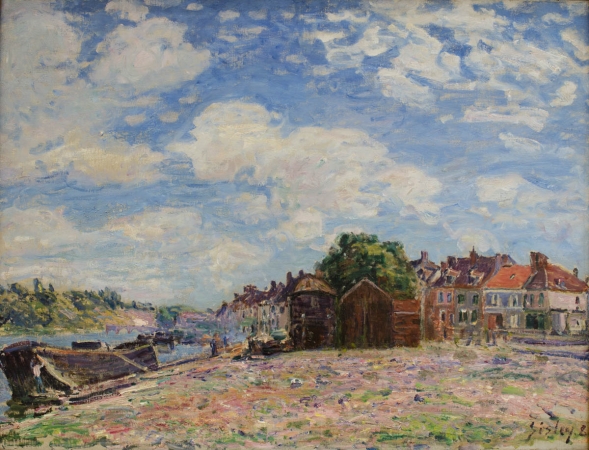Sisley, The Loing at Saint-Mammès

Alfred SISLEY (1839-1899)
The Loing at Saint-Mammès
1885
oil on canvas
55 x 73.2 cm
© MuMa Le Havre / David Fogel
The Loing at Saint-Mammès
1885
oil on canvas
55 x 73.2 cm
© MuMa Le Havre / David Fogel
HD image
podcast
Born in Paris to an English family, Alfred Sisley (1839–1899) was sent to the United Kingdom when he was eighteen. There is where he discovered, prior to the Impressionists, the work of Turner, who was widely exhibited in London, and the work of Constable, another undisputed master of the English landscape. Continuing financial difficulties quickly brought him back to the Paris area, first to Louveciennes, then Marly. After 1880, he settled in the Moret-sur-Loing area, where he remained until his death.
From 1882 to 1885, Sisley explored the banks of the Loing. Between Moret, a medieval town in the countryside, and Saint-Mammès, renowned for its shipbuilding and traditional trades, Sisley worked from a wide range of vantage points. In 1885, the group of houses near the locks caught his attention and provided him with the motif for a set of compositions akin to a series. Sisley systematically surveyed the area, making sketches in his notebooks and recording technical details. Despite the ambiguity of the title—The Loing at Saint-Mammès—, Sisley seems to have positioned himself at the exact confluence of the river and the Seine, on the bank of the Loing, his gaze sweeping over the river and the tiny town.
The main protagonist in this landscape, the sky absorbs two thirds of the composition. Like Constable when he conducted a systematic study of cloud types, Sisley attributed an "architectural" role to the sky, using different planes to give his painting depth. In the majestic "foreground" of the bank, a genuine space of pure abstraction, the artist casts the shadow of the clouds in free and energetic touches, as if on a colour palette. Each plane is given its own characteristic touch: the lively and sumptuous brushstrokes of the bank, the structured colour blocks of the houses, the vibrant lightness of the plants, and the transparency of the sky.
In the 1880s, Sisley, like the Impressionists, pondered the inherent properties of colour. His answer was to accentuate each shade and develop a colour range later found in 1897 in his coastal views of Wales.
From 1882 to 1885, Sisley explored the banks of the Loing. Between Moret, a medieval town in the countryside, and Saint-Mammès, renowned for its shipbuilding and traditional trades, Sisley worked from a wide range of vantage points. In 1885, the group of houses near the locks caught his attention and provided him with the motif for a set of compositions akin to a series. Sisley systematically surveyed the area, making sketches in his notebooks and recording technical details. Despite the ambiguity of the title—The Loing at Saint-Mammès—, Sisley seems to have positioned himself at the exact confluence of the river and the Seine, on the bank of the Loing, his gaze sweeping over the river and the tiny town.
The main protagonist in this landscape, the sky absorbs two thirds of the composition. Like Constable when he conducted a systematic study of cloud types, Sisley attributed an "architectural" role to the sky, using different planes to give his painting depth. In the majestic "foreground" of the bank, a genuine space of pure abstraction, the artist casts the shadow of the clouds in free and energetic touches, as if on a colour palette. Each plane is given its own characteristic touch: the lively and sumptuous brushstrokes of the bank, the structured colour blocks of the houses, the vibrant lightness of the plants, and the transparency of the sky.
In the 1880s, Sisley, like the Impressionists, pondered the inherent properties of colour. His answer was to accentuate each shade and develop a colour range later found in 1897 in his coastal views of Wales.
























